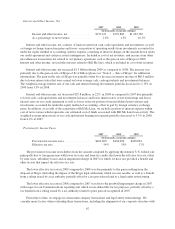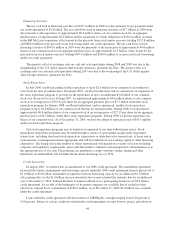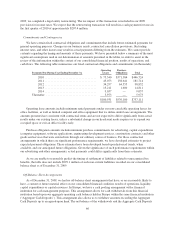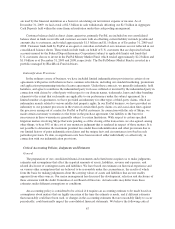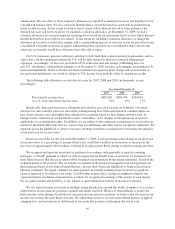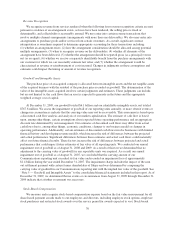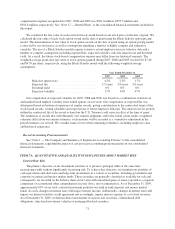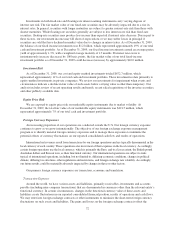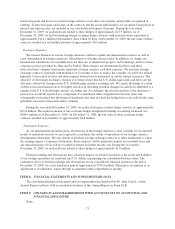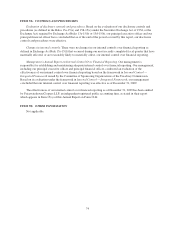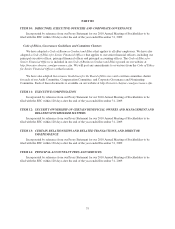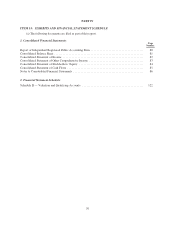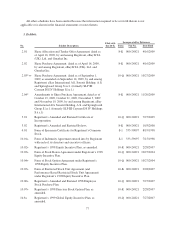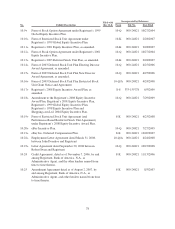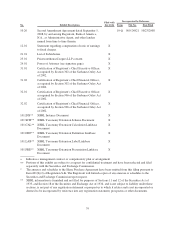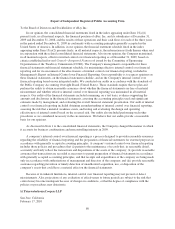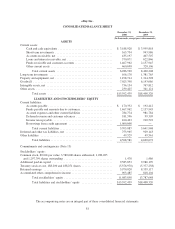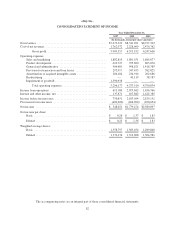eBay 2009 Annual Report Download - page 80
Download and view the complete annual report
Please find page 80 of the 2009 eBay annual report below. You can navigate through the pages in the report by either clicking on the pages listed below, or by using the keyword search tool below to find specific information within the annual report.Investments in both fixed-rate and floating-rate interest-earning instruments carry varying degrees of
interest rate risk. The fair market value of our fixed-rate securities may be adversely impacted due to a rise in
interest rates. In general, securities with longer maturities are subject to greater interest-rate risk than those with
shorter maturities. While floating rate securities generally are subject to less interest-rate risk than fixed-rate
securities, floating-rate securities may produce less income than expected if interest rates decrease. Due in part to
these factors, our investment income may fall short of expectations or we may suffer losses in principal if
securities are sold that have declined in market value due to changes in interest rates. As of December 31, 2009,
the balance of our fixed income investments was $1.2 billion, which represented approximately 19% of our total
cash and investment portfolio. As of December 31, 2009, our fixed income investments earned an average pretax
yield of approximately 1.3%, with a weighted average maturity of 13 months. If interest rates were to
instantaneously increase (decrease) by 100 basis points, the fair market value of our total fixed-income
investment portfolio as of December 31, 2009 could decrease (increase) by approximately $10.0 million.
Investment Risk
As of December 31, 2009, our cost and equity method investments totaled $672.7 million, which
represented approximately 11% of our total cash and investment portfolio. These investments relate primarily to
equity-method investments in private companies. We review our investments for impairment when events and
circumstances indicate a decline in fair value of such assets below carrying value is other-than-temporary. Our
analysis includes review of recent operating results and trends, recent sales/acquisitions of the investee securities,
and other publicly available data.
Equity Price Risk
We are exposed to equity price risk on marketable equity instruments due to market volatility. At
December 31, 2009, the total fair value of our marketable equity instruments was $421.5 million, which
represented approximately 7% of our total cash and investment portfolio.
Foreign Currency Exposures
An increasing proportion of our operations are conducted outside the U.S. Our foreign currency exposure
continues to grow as we grow internationally. The objective of our foreign exchange exposure management
program is to identify material foreign currency exposures and to manage these exposures to minimize the
potential effects of currency fluctuations on our reported consolidated cash flow and results of operations.
International net revenues result from transactions by our foreign operations and are typically denominated in the
local currency of each country. These operations also incur most of their expenses in the local currency. Accordingly,
certain foreign operations use the local currency, which is primarily the Euro, and to a lesser extent, the British pound
Australian dollars and Korean won, as their functional currency. Our international operations are subject to risks
typical of international operations, including, but not limited to, differing economic conditions, changes in political
climate, differing tax structures, other regulations and restrictions, and foreign exchange rate volatility. Accordingly,
our future results could be materially adversely impacted by changes in these or other factors.
Our primary foreign currency exposures are transaction, economic and translation.
Transaction Exposure
Around the world, we have various assets and liabilities, primarily receivables, investments and accounts
payable (including inter-company transactions) that are denominated in currencies other than the relevant entity’s
functional currency. In certain circumstances, changes in the functional currency value of these assets and
liabilities create fluctuations in our reported consolidated financial position, results of operations and cash flows.
We may enter into foreign exchange contracts or other instruments to minimize the short-term foreign currency
fluctuations on such assets and liabilities. The gains and losses on the foreign exchange contracts offset the
72


